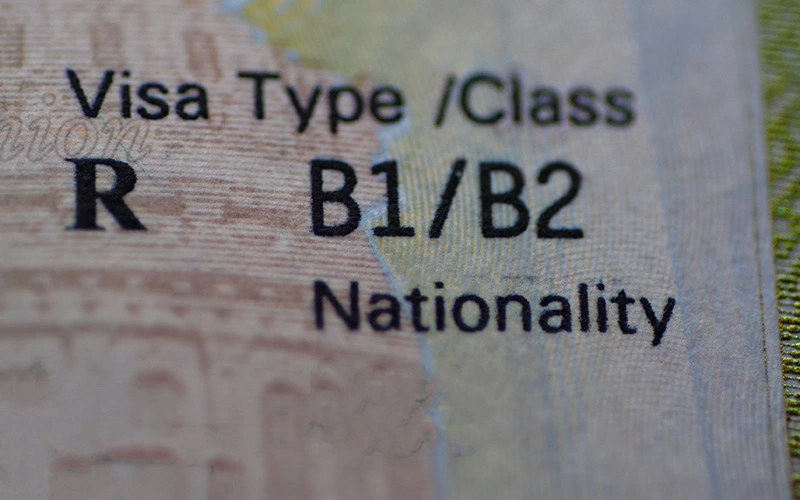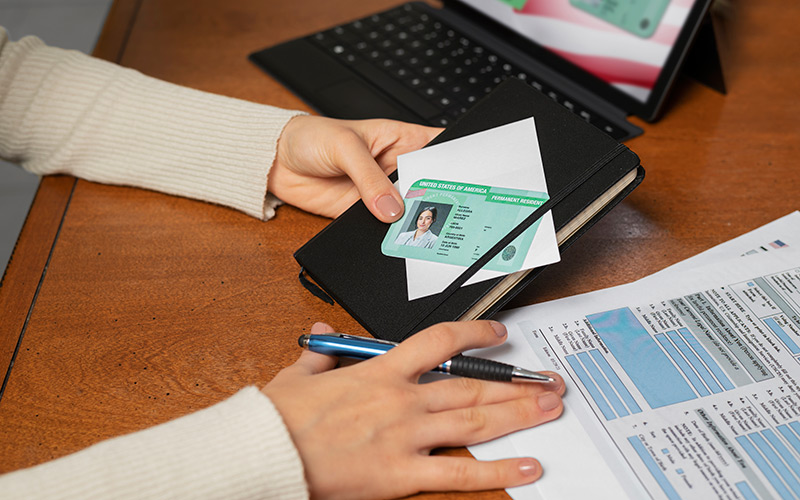It is very common for many people to enter the U.S. on a B1 or B2 visa for business, tourism or visiting family. But for some, the trip becomes an opportunity to explore new possibilities in the country and they might want to stay here permanently. But to do that they need to learn how to convert a B1/B2 visa into green card status. The purpose of this how to change B1/b2 visa to green card guide is to fully explain the process, B1/b2 visa requirements, and legal considerations that visitors must follow when planning to adjust temporary status from the US B1 visa or US B2 visa status to obtaining a Green Card.
Overview of B1/B2 Visas
The B1 visa caters to those entering the U.S. for business purposes, like meetings, negotiations, and conferences. The us b2 visa is granted for tourism, family visitation, or medical treatment.
B1/B2 visa holders should depart the United States at the end of their authorized stay. Even though you do have the option to apply for an extension, you will need solid reasoning for this and require the approval of immigration officials.
Understanding Green Cards
The Green Card, actually known as a Permanent Resident Card, gives an individual permanent resident status in the United States. Green Card holders have greater stability than temporary visa holders and are able to pursue long-term opportunities and eventual citizenship.
There are many advantages of having a Green Card, like, freedom of choice of job, eligibility for social security, sponsoring certain relatives for permanent residence, etc. It is a huge step toward a life that is completely established in the United States.
Understanding B1/B2 Visas

Eligibility Criteria
US B1 visa or B2 applicants must establish that they have strong ties to their home country, are financially capable of paying for their trip and have clear reasons to temporarily come to the United States.
Limitations
B1/B2 visa holders may not work in the U.S. Working in the U.S. without authorization can lead to revocation of the visa and bans on future immigration. The B1 visa is for US business visa activities, while the B2 visa is for tourism and family visits.
Intent at Entry
The B1/B2 visa is a non-immigrant visa status, and the traveler must indicate they do not intend to immigrate upon entry. Demonstrating immigrant intent, either when arriving at a border or in a visa interview, can result in a denial of entry or future immigration difficulties.
Pathways to a Green Card from B1/B2 Status

Adjustment of Status (AOS)
Adjustment of Status is the process allowing those who are already in the United States to apply for their Green Card without having to leave the United States. Applicants under the B1/B2 visa looking to get a Green Card must file Form I-485.
Consular Processing
Consular processing means going back to the applicant’s home country to apply for an immigrant visa through a U.S. consulate. This route is commonly taken if the applicant cannot lawfully adjust status in the U.S.
Adjustment of Status eliminates the need for travel and lets the applicant reside in the U.S. but it requires the applicant to maintain lawful status. Consular processing likely requires more travel but may be the only option if the status has been violated.
Family-Based Green Card Options
Immediate Relatives
Immediate relatives of U.S. citizens such as spouses, unmarried children below 21, and parents can apply for a Green Card immediately. Hence this is the fastest possible family-based route.
Other Family Categories
Married children, brothers and sisters of U.S. citizens, and spouses and children of Green Card holders also qualify but must endure longer waits because there are yearly limits on visas in those categories.
Application Process
The family member who will be sponsoring them files Form I-130 to initiate the process. If approved, and a visa is available, he/she may file Form I-485 (Application for Adjustment of Status) in the U.S. or go to consular processing abroad.
Employment-Based Green Card Options
EB-1, EB-2, EB-3 Categories
Employment-based Green Cards are classified into categories based on skills and qualifications. EB-1 is for people with extraordinary ability, EB-2 is for professionals with advanced degrees and EB-3 is for skilled workers.
Labor Certification (PERM)
Most EB-2 and EB-3 candidates will require their employer to go through the labor certification (PERM) process to prove that no qualified U.S. workers are available to fill the offered position to the foreign worker.
Application Steps
The employer must first obtain labor certification, second file Form I-140 and finally file Form I-485 if the applicant is in legal status in the U.S.
Investment-Based Green Card (EB-5)
Overview of EB-5 Program
The EB-5 program provides Green Cards to investors that invest a required amount in a U.S. business and create a minimum of ten full-time jobs for U.S. workers.
Regional Centers vs. Direct Investment
A USCIS-approved Regional Center project usually handles compliance, job creation, etc., or investors can opt for direct investment.
Application Process
Investors must submit Form I-526 to prove their eligibility. Upon fulfillment of investment and job creation requirements, they file Form I-829 to remove conditions from their Green Card.
Special Categories and Humanitarian Options
Asylum and Refugee Status
Asylum is available to persons who have been persecuted or fear persecution based on race, religion, nationality, political opinion, or social group membership. They can file for a Green Card after one year of approval.
U Visa and T Visa
Victims of specific crimes (U Visa) and human trafficking (T Visa) can receive these special visas and then adjust to permanent resident status after meeting certain criteria.
VAWA
Violence Against Women Act for Abused spouses, sexual or abuse victims, children, or parents of U.S. citizens or Green Card holders. They are allowed to self-petition for a Green Card without the cooperation of the abuser.
Legal Considerations and Challenges
Maintaining Legal Status
By the terms of the B1/B2 visa, it is important to stay within the parameters of the visa. And overstaying or violating any visa conditions can greatly complicate things or even make it impossible for B1/B2 visa adjustment of status.
90-Day Rule
The 90-day rule by USCIS is used to determine changes in intent. Applying for adjustment within 90 days of entering the country may suggest that the person lied about their original intent.
Dual Intent Doctrine
Unlike other US visa like H-1B, the B1/B2 visa is not Dual Intent, which means it is strictly temporary. Using it for permanent residence plans shortly after entering, however, can land the recipient in legal trouble.
Application Process and Documentation
Forms and Fees
Most common forms are I-130, I-140 and I-485. Each of the above forms has its own filing fee and biometric service fee.
Supporting Documents
In their application, applicants are required to provide proof in the form of birth certificates, marriage licenses, bank statements, and prior immigration information.
Medical Examination
A medical examination must be performed by an approved civil surgeon of the USCIS and is a part of the Green Card application through Form I-693.
Interview Preparation and Biometrics
- All applicants are required to attend a biometrics appointment during which fingerprints, photos and digital signatures are collected for background checks.
- During the interview, a USCIS officer may ask the applicant questions regarding their background, to determine why they are seeking to immigrate, and if they are eligible for a Green Card.
After the interview, USCIS may either approve, issue a request for evidence, or deny the case. If the application is approved, the applicant will receive their Green Card through the mail shortly thereafter.
Conclusion
Conversion of the B1/B2 Visa to a Green Card can seem complex but it is achievable. With adequate planning and compliance with the law, it is absolutely possible to obtain permanent resident status and become citizens of the next generation holders of US visa B1, US visa B2, or US Business Visa.

